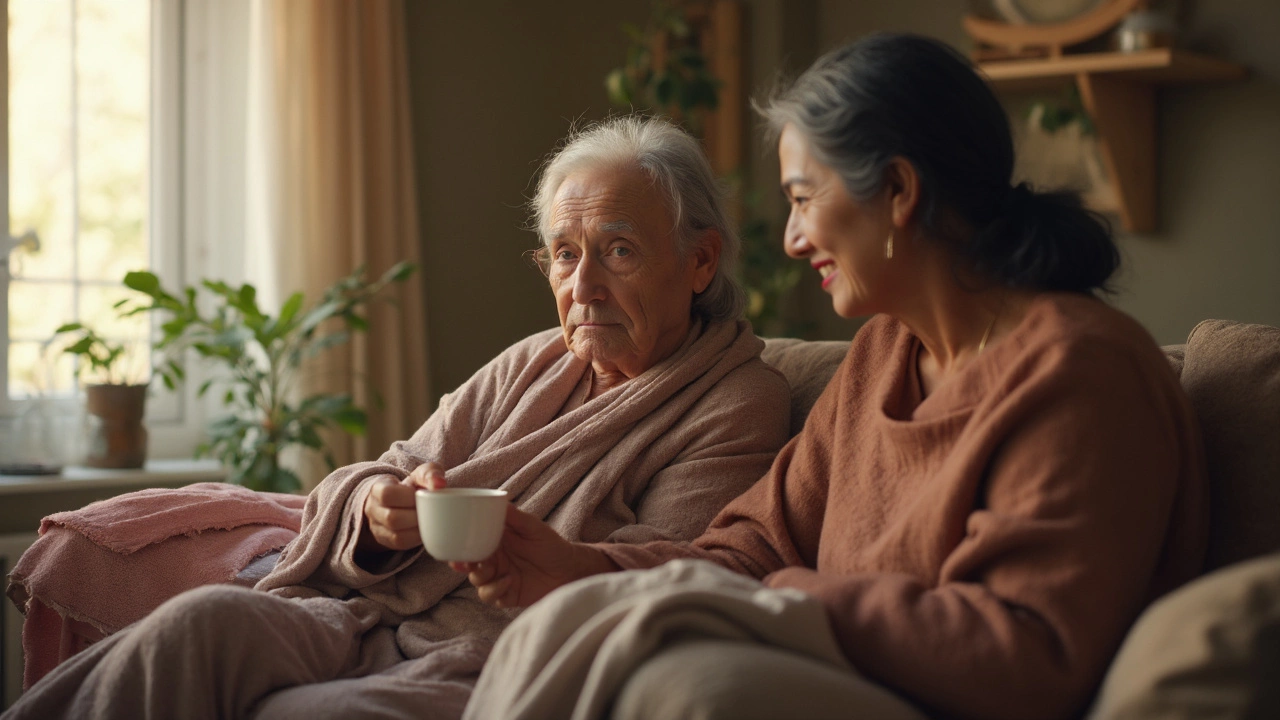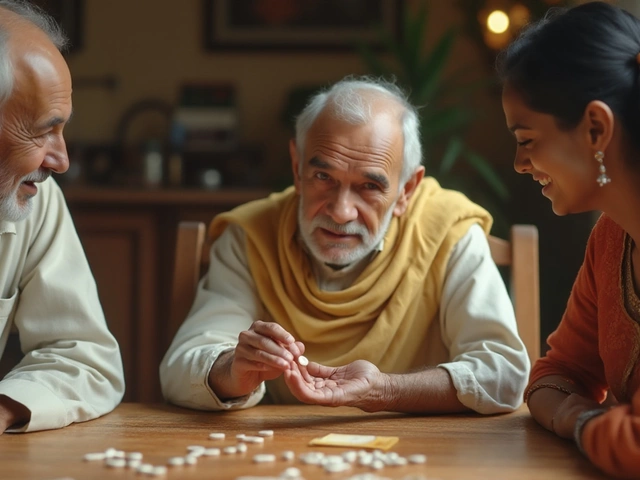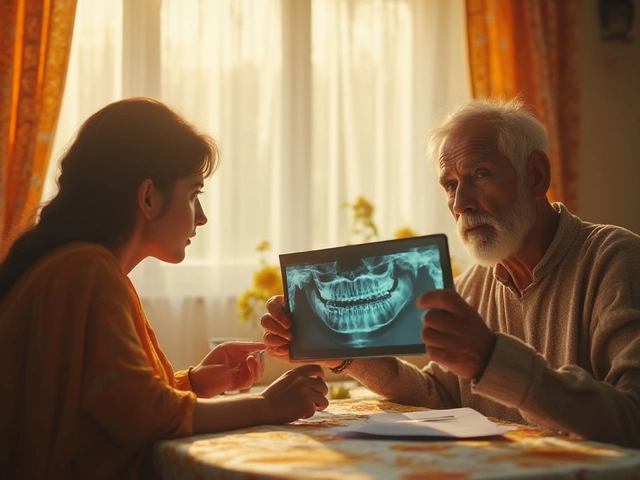
The days after chemo can feel like running into a brick wall. The first 2–4 days after treatment, side effects usually peak—and for many, that’s the toughest time to get through. Nausea, bone-crushing tiredness, and weird changes in taste or smell? That’s just the start.
If you’ve got stuff to do—work, kids, taking care of a dog like my Shadow—it can suddenly feel impossible. Even normal routines, like cooking or showering, might feel way harder than you ever imagined. Knowing when these low points hit (and that they won’t last forever) can make it a little less scary.
One thing most people don’t realize: everyone’s hardest day can be different, depending on the type of chemo drugs, your own health, and how many rounds you’ve been through. Some people bounce back in a day or two, while others need a full week to start feeling human again. Tracking how you feel after each round (seriously—keep notes, even on your phone) helps spot patterns and can be a game changer when talking with your doctor about tweaks to your treatment plan.
- Why the Days After Chemo Hit Hard
- Most Common Symptoms (and When They Peak)
- Hidden Struggles Nobody Talks About
- What Actually Helps: Real Tips
- Signs You Should Call Your Doctor
Why the Days After Chemo Hit Hard
The days straight after chemo are rough because the drugs aren’t picky—they go after any fast-growing cells, good or bad. While they’re attacking cancer cells (which is the point), they’re also messing with healthy stuff: cells in your gut, hair, and bone marrow. That’s why side effects sneak up so quickly and hit so hard.
Here’s what’s actually going on: When chemo goes into your system, it doesn’t leave right away. Most chemo drugs hang around for at least 24-72 hours, and that’s when things like nausea, fatigue, and mouth sores start showing up big time. Your body’s also busy trying to clear out the chemo, using your liver and kidneys—so add in that workload, and you see why energy tanks and recovery can feel impossible.
One study out of Memorial Sloan Kettering found that patients most often peaked with the worst nausea and exhaustion about two days after a chemo dose. So if you’re checking the calendar and counting hours, that second and third day, for many people, are just brutal. Knowing this helps you plan for rest or ask for help when you need it most.
| Side Effect | Average Peak (Days After Chemo) |
|---|---|
| Nausea and vomiting | 1-3 days |
| Extreme fatigue | 2-4 days |
| Mouth sores | 3-7 days |
| Neutropenia (low white blood cells) | 7-14 days |
A big fact people miss: It’s not just what the chemo does, but also how your immune system basically takes a vacation. Your white blood cells drop fast, so your body can’t fight off stuff it normally would—leaving you more wiped out than a late night with no coffee.
Bottom line? The hardest days after chemo happen because your body gets hit from all sides at once. If it feels like too much, you’re not imagining it—it’s just the reality of how chemo works in your body, and the timing makes those first few days the hardest hurdle to get over.
Most Common Symptoms (and When They Peak)
Let’s get real about what actually happens the first few days after chemo. The hardest days usually pack the worst of the side effects, and they don’t always look the same for everyone. Here’s what tends to show up the most, and when you should be on the lookout.
- Nausea and Vomiting: This one tops the list. Most people get the worst nausea within the first 24–48 hours after chemo. A lot of the newer anti-nausea meds help, but don’t be surprised if you still have some queasy days.
- Fatigue: The crushing tiredness often hits a day or two after treatment and can hang around for up to a week. It’s not just regular tired—think wiped out, even after a nap.
- Mouth Sores and Taste Changes: These usually creep in by day 3 or 4. Your favorite foods might suddenly taste totally off, or eating might just plain hurt.
- Low Blood Counts: Symptoms like bruising easily or feeling dizzy usually start to show up a week or so after chemo, but the process kicks off right away as your bone marrow gets hit.
- Digestive Issues: Constipation or diarrhea can hit fast, sometimes even dose to dose. Drink more water and stay close to a bathroom just in case.
This cheat sheet shows roughly when side effects tend to peak for the average round of chemo:
| Symptom | Usual Peak Time |
|---|---|
| Nausea/Vomiting | 1-2 days after chemo |
| Fatigue | 2-3 days after chemo |
| Mouth Sores | 3-7 days after chemo |
| Taste Changes | 3-5 days after chemo |
| Digestive Problems | Within first 3 days, can last up to a week |
Why does all this happen? Those hardest days after chemo are mostly about how quickly chemo drugs hit fast-growing cells—like the stomach lining or hair roots—right after treatment. Your body fights back, but it takes time. Knowing when each symptom usually shows up can make it easier to prepare and plan some helpful hacks in advance.

Hidden Struggles Nobody Talks About
Ask anyone who's been through chemo, and they'll tell you: it’s not just about the stuff your doctor warns you about. The hardest days after chemo can sneak up on you in ways nobody really explains. You can suddenly feel like you’re on an island, even when people are checking in every hour. That sense of isolation? Totally normal, but not always talked about.
Let’s get specific. Chemo brain (yep, it’s real) messes with your memory and focus—some people say it feels like living in a fog. Family and friends might expect you to "just rest," but the mental struggle is more than just being tired. Here’s the thing: almost 75% of chemo patients report trouble with memory or concentration within days of treatment.
Then there’s food. Tastes change so much that a favorite meal might suddenly seem disgusting. One study from 2023 found that up to 60% of patients lose their appetite completely during chemo’s roughest days. On top of that, smells in the house—or even a whiff of your own shampoo—can make nausea way worse.
Here's a look at how some hidden struggles show up for most people dealing with chemo:
- Relationships get tense: Loved ones might not get how wiped out you feel, and it’s easy to snap or get annoyed over little things.
- Anxiety and mood swings: One day you’re up, next day you can’t stop crying. Totally unfair, but pretty common.
- Weird body stuff nobody warned you about: Mouth sores, bad skin rashes, and taste changes can mess with self-confidence.
- Sleep is a mess: Between steroids, pain, or just worry, getting decent sleep is a struggle for over half of patients during this phase.
For a quick view, here’s how common some of these hidden symptoms are:
| Hidden Symptom | How Common (out of 10) |
|---|---|
| Chemo brain (memory/focus) | 7–8 |
| Sleep problems | 6–7 |
| Mood swings/anxiety | 5–7 |
| Major taste changes | 6 |
| Mouth sores/rashes | 4–6 |
Bottom line: don’t brush off these struggles or keep them bottled up. Talking to someone who gets it, whether it's another patient or a support group, can really help. Chemo might be rough, but none of these struggles mean you’re alone in it.
What Actually Helps: Real Tips
Dealing with the hardest days after chemo usually means tackling nausea, feeling wiped out, and just making it through daily stuff. None of these problems have a magic fix, but a few simple things actually make a real difference.
- Stay hydrated—but don’t overdo it all at once. Water and drinks like electrolyte solutions are better than sugary sodas. Sipping slowly through the day helps if drinking a lot at once makes you queasy.
- Eat what you can tolerate. No judgment if that’s crackers or toast for a while. Forget balanced meals; think bland, small bites. A nurse once told me, “Any calories count on your worst days.”
- Rest when you need to. Some people push themselves to stick to a schedule like they’re not in chemo. Your body is fighting hard—sleep whenever you need it, even if that means a random nap at 3pm. Many folks need more rest the third day after chemo, when fatigue often peaks.
- Manage nausea with meds and home tricks. Don’t wait until you’re sick to take anti-nausea drugs—take them as your doctor says, even if you feel okay. Ginger chews and cold foods (like popsicles) help some people more than warm meals.
- Light movement helps with fatigue. Even a short walk around the house gets your blood moving. If you have a dog, like my mutt Shadow, sitting on the porch with them can be a decent substitute on those extra rough days.
- Track your symptoms. Write down when the worst side effects happen. There’s even an app (like ChemoWave) that makes tracking easy, or just use notes on your phone. This helps you (and your doctor) notice patterns or changes.
If you’re looking for data, one published survey showed over 60% of patients reported their most intense fatigue within three days after finishing a chemo dose. Appetite loss and taste changes peak in that window too—which explains why small, bland snacks and hydration are top tips from cancer centers everywhere. Here’s a look at what most people report as their worst symptoms and when they hit:
| Symptom | Peak Day After Chemo | How Common (%) |
|---|---|---|
| Nausea | 1-3 | 70 |
| Fatigue | 2-4 | 85 |
| Taste Changes | 2-5 | 65 |
| Mouth Sores | 5-7 | 40 |
Don’t forget—not every tip works for everyone. Try a few things out, adjust as you go, and ask your oncology nurse what’s worked for other patients. If in doubt, always check in before starting anything new, especially with herbal teas or supplements, since some stuff messes with your meds.

Signs You Should Call Your Doctor
The toughest part about chemo’s aftermath is figuring out what’s just normal pain and what’s a sign you need help. Trust me, if something feels off, don’t brush it off. Doctors and nurses want those calls—catching problems early can save you a world of trouble down the line.
Here are some specific signs that mean your care team needs to know, right away:
- Fever over 100.4°F (38°C): Even a slight fever after chemo can mean you’re fighting an infection. Your immune system is on vacation, so don’t wait this one out.
- Chills, shakes, or sweating: Same deal—these usually go with fever and can mean infection.
- Mouth sores that make it hard to swallow or drink: If you can’t stay hydrated, you’ll end up sicker fast.
- Uncontrolled nausea or vomiting: Can’t keep food or water down for more than 24 hours? Call, because dehydration can get serious fast.
- Shortness of breath or chest pain: Don’t wait—get help immediately.
- Confusion, vision changes, or trouble waking up: These are not normal chemo side effects and need urgent attention.
- Bleeding you can’t stop, blood in vomit, pee, or poop: Even a little is worth a call.
- Rash or swelling, especially if it comes on quickly: Allergies or infections can get bad fast.
Sometimes people wonder how often these things happen. Here’s a look based on actual patient data:
| Complication | How Often (%) |
|---|---|
| Fever and infection | 20–30 |
| Severe nausea/vomiting | 10–20 |
| Mouth sores (severe) | 8–15 |
| Bleeding | 5–10 |
Keep the after-hours number handy (seriously, save it in your phone). Don’t worry about bugging anyone. With chemo, even little problems can get big if left alone. If you’re not sure, call—better safe than sorry when you’re managing hardest days after chemo.





Rohan Talvani
I am a manufacturing expert with over 15 years of experience in streamlining production processes and enhancing operational efficiency. My work often takes me into the technical nitty-gritty of production, but I have a keen interest in writing about medicine in India—an intersection of tradition and modern practices that captivates me. I strive to incorporate innovative approaches in everything I do, whether in my professional role or as an author. My passion for writing about health topics stems from a strong belief in knowledge sharing and its potential to bring about positive changes.
view all postsWrite a comment